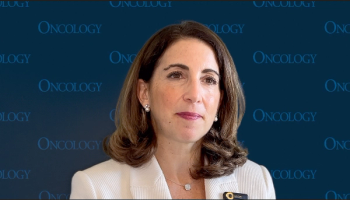
- Oncology NEWS International Vol 12 No 3
- Volume 12
- Issue 3
Dose-Dense Adjuvant Chemotherapy Reduces Mortality and Recurrence in Node-Positive Breast Cancer
SAN ANTONIO, Texas-In women with node-positive breast cancer, shortening the time between adjuvant chemotherapy cycles significantly reduces mortality and risk of recurrence, with no significant increase in toxicity, according to results of a large, randomized cooperative group trial. Interim analysis from Cancer and Leukemia Group B (CALGB) 9741 showed that dose-dense chemotherapy reduced mortality by 31% and risk of recurrence by 26% vs conventional administration.
SAN ANTONIO, TexasIn women with node-positive breast cancer, shortening the time between adjuvant chemotherapy cycles significantly reduces mortality and risk of recurrence, with no significant increase in toxicity, according to results of a large, randomized cooperative group trial. Interim analysis from Cancer and Leukemia Group B (CALGB) 9741 showed that dose-dense chemotherapy reduced mortality by 31% and risk of recurrence by 26% vs conventional administration.
Lead investigator Marc L. Citron, MD, clinical professor of medicine with Albert Einstein College of Medicine, Bronx, New York, presented the results at the 25th Annual San Antonio Breast Cancer Symposium.
"While previous research has evaluated the use of different forms of ‘dose-dense’ chemotherapy, this is the first major controlled study to show a clear survival benefit for women with node-positive breast cancer," according to a statement by the National Cancer Institute.
Dr. Citron said that the improved rates for disease-free survival and overall survival warrant further research and have implications for practice.
Four Treatment Groups
Investigators accrued 2,005 patients between September 1997 and March 1999 and 1,973 of those patients received therapy and were evaluable. The median age was 50 and about half of the women were premenopausal. The median number of positive nodes was three.
All women had received lumpectomy and axillary dissection, or a modified radical mastectomy with clear margins. Following surgical removal of their tumors, the women were randomized to one of four treatment groups involving the following schedule of doxorubicin 60 mg/m2, paclitaxel 175 mg/m2 over 3 hours, and cyclophosphamide 600 mg/m2.
The trial was designed to test dose dense vs conventional chemotherapy and concurrent vs sequential chemotherapy. Filgrastim (Neupogen) was added to the dose-dense groups to help prevent neutropenia. The dose of filgrastim was 5 mg/kg subcutaneously for a total of seven doses, starting on day 3 of each cycle of chemotherapy. Tamoxifen 20 mg/day starting within 12 weeks after completing chemotherapy was recommended but not required for all of the receptor-positive patients and postmenopausal receptor-negative patients.
Arm I: sequential administration of doxorubicin, followed by paclitaxel, followed by cyclophosphamide in 3-week intervals.
Arm II: sequential administration of doxorubicin, followed by paciltaxel, followed by cyclophosphamide in 2-week intervals (dose dense), with filgrastim.
Arm III: concurrent administration of doxorubicin and cyclophosphamide, followed by paclitaxel in 3-week intervals.
Arm IV: concurrent administration of doxorubicin and cyclophosphamide, followed by paclitaxel in 2-week intervals (dose dense), with filgrastim.
Significantly Superior Survival
At 36 months median follow-up, dose-dense treatment was associated with a 26% relative reduction in relapse (P = .01) vs every 3 weeks administration. Four-year disease-free survival was 82% in the dose-dense group and 75% for the conventional dosing schedule.
There was also a 31% relative reduction in mortality for dose-dense treatment vs conventional dose scheduling (P = .013). Three-year overall survival was 92% for the dose-dense group and 90% for the every 3 weeks group.
Giving chemotherapy sequentially vs concurrently had no impact on efficacy.
Toxicities Were Acceptable
While toxicities were acceptable for both arms, the hematologic toxicity profile of the dose-dense approach was somewhat more favorable (see
Investigators cautioned that additional follow-up will be needed to confirm this survival benefit. "The maximum follow-up is only 5 years, and treatment-related patterns of recurrence and toxicity may emerge" with longer follow-up, Dr. Citron said. Economic issues may also need to be addressed, since filgrastim may make the dose-dense approach more expensive.
Articles in this issue
over 22 years ago
Elevated Serum HER2/neu Linked to Lower Response to Hormone Therapyover 22 years ago
Are We Closing in on a Blood Test for Breast Cancer?over 22 years ago
Trial Lays Groundwork for All-Oral Capecitabine/Vinorelbineover 22 years ago
Fulvestrant Is Effective for Patients Failing Other Hormonal Therapyover 22 years ago
Double Transplant Increases Survival in Myeloma Patientsover 22 years ago
Smoking Worsens Prognosis in Cervical Cancer PatientsNewsletter
Stay up to date on recent advances in the multidisciplinary approach to cancer.

















































































